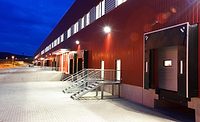Why manufacturers should upgrade their BEMS system

One of the key areas within this has been building controls, which has allowed facilities operators to increase throughputs at a time when remote working has replaced traditional working practices.
Keeping day to day operations afloat, Building Energy Management Systems (BEMS) are an integral unit of automation, with estimates placing the market for their use at a staggering £19.25 bn by 2023.
Acting as an interface between the extensive mechanical and electrical equipment all at play within large manufacturing facilities, these interlinked systems can represent up to 70% of a building’s energy usage, placing a huge impetus on maintenance upkeep.
Here, David Barnes, managing director of adi Intelligent Buildings, a division of engineering firm adi Group, explains how maintaining BEMS efficiency standards should be at the forefront of manufacturer’s minds, or risk facing unmet efficiency goals and cost-heavy downtime.
A Building Energy Management System, also known as a BEMS, monitors and controls building services including HVAC and lighting, and process related systems such as compressed air, chilled water and steam. Many systems are fully integrated with building fire, access control and energy monitoring platforms.
With the supply and demand of energy use having been pushed to the maximum throughout the pandemic, particularly in critical manufacturing sectors such as pharmaceutical and food and beverage, it makes perfect sense for businesses, manufacturers, and workplaces to be utilizing a BEMS, one which can maintain and dictate process efficiency to drive sustainable operational goals.
However, operational infrastructure can become an element of neglect, particularly when demand hits critical production points. Statistics show that improperly configured BEMS systems can account for 20% of building energy usage. To minimize this financial burden, it is imperative business owners understand why they should treat these systems as integral elements of maintenance and upgrade. Here’s more on why:
Improves energy efficiency
Many businesses and industries, as well as individuals, are working towards leading a more sustainable lifestyle—a BEMS system can be a major contributing factor to this vision.
Buildings that use these systems are approximately 22% more efficient than those without, yielding both financial and environmental benefits.
If your BEMS is outdated or no longer working as it should, this can cause it to become inefficient, negatively impacting energy efficiency goals and the environment as a result.
By updating or upgrading your BEMS, manufacturers can ensure their environments improve or maintain energy efficiency.
Remain up to date
Just like any other piece of software or technology, a BEMS can go out of date. And not in the way of an expiry date.
For many businesses, a BEMS is an inherent part of production, particularly for food and pharmaceutical manufacturers, who must ensure that their products are stored at certain temperatures and produced in the correct climates.
Without being updated or upgraded, a BEMS can increase service costs, decrease comfort levels and result in failed production, leading to further financial burden and implications for businesses.
In addition, older systems can represent a cybersecurity risk being run on older software platforms.
Why wait until your current system fails, or lacks in reliability to update it? By regularly servicing your BEMS, and planning for upgrades, you stay one step ahead of the curve and minimize operational loss.
Increases productivity
BEMS also provide environmental controls, and the environment in which people work can have a huge effect on comfort, productivity, and wellbeing.
Whatever industry or sector you work in, this is definitely something to consider.
If employees aren’t comfortable and are working in environments that are too warm or too cold, this could have a negative impact on the business.
A report published by Savills and The British Council for Office shows that 48% of people believe that the office can positively influence their mood and mental health, with temperature being one of the most important factors. Like the products that are being developed, employees also need to operate within comfortable climates to be at their best, which is where a fully functioning and operational BEMS can come into play to dictate temperature matters.
Common mistakes to avoid
Whilst there are various ways in which a BEMS can benefit a business or manufacturer when upgraded, there are also a few things to consider beforehand.
Consider the complete system. When a BEMS begins to fail, many customers will start to consider the upgrade, gathering costs to replace the BEMS controllers without looking at the complete system and original installation.
If, for example, the original BEMS was installed 20 years ago, then it is likely that wiring, control panels, the associated field equipment (sensors, valves, actuators) and plant (HVAC), may also be of the same age.
Replacing the BEMS controllers, without replacing faulty valves and actuators, will provide minimal benefit. Not considering the condition of existing wiring and control panels may also result in health and safety implications.
Here are some more mistakes to avoid:
1. Don’t assume you must upgrade to the same system
In some sense, moving to the latest platform of an existing system may seem like a natural next step - the manufacturer may have the tools and processes to make it a smoother and more cost-effective route.
However, by employing the help of a BEMS expert, you will be able to consider a number of systems and find the best one to suit your building requirements.
As with any kind of market (and particularly technology) the needs and wants of today evolves at such at rapid pace, that the architecture to support it can either fall behind or scale accordingly. Speak to your BEMS advisor to understand which providers are operating with a high degree of productivity, return on investment and enhanced security for your business conditions.
2. Not considering a change in business needs
Naturally, the needs of businesses can change, alongside building layouts, and this is even more apparent after the recent coronavirus pandemic. For example, was your cold storage originally maintained to six, but is now 12 degrees? However subtle or small over the years, enhancements or condition changes affect plant loading and control strategies, and therefore need to be taken into account to ensure the ongoing efficiency of your building.
3. Waiting for it to break
Don’t just wait for your BEMS to break.
Businesses should plan and prepare for an upgrade and should always think ahead. Consider your business plans, goals and changes, and then see where your current BEMS fits in and when it will be best to fit in an update. Naturally, a business may plan three to four years ahead at a time, so why not take into account your BEMS in this objective mix?
The future of BEMS
Going forwards, most, if not all businesses have been impacted by Covid-19, with business needs and requirements having changed quite dramatically.
Whilst many industries and businesses have adapted to new ways of working, they must too, adapt the way in which they choose to control and monitor their environments.
Particularly for food and beverage, pharmaceuticals and educational sectors, BEMS will take center stage, playing a huge part in each industry’s development.
It is no longer enough to make do or to anticipate failures in technology. We must think ahead, plan for the future and work to a continual upgrade pattern, rather than be averse to change.
And, alongside the wider adi Group, adi Intelligent Buildings can support more detailed upgrades, as well as provide the mechanical and electrical expertise manufacturers require.
With the ability to spot and recognize issues, we have the capacity to supply first-class solutions across a variety of sectors. So, make changes now, to ensure a safer, more efficient future for all.
Looking for a reprint of this article?
From high-res PDFs to custom plaques, order your copy today!







